In this article we're going to be going over on-page and technical SEO. If you don't make the right changes and adapt your site to Google from a code perspective, you're not going to rank well.
Everyone knows that linkable content wins. The more people that link to you the easier it is for Google to find your site and the higher that you're going to end up ranking. 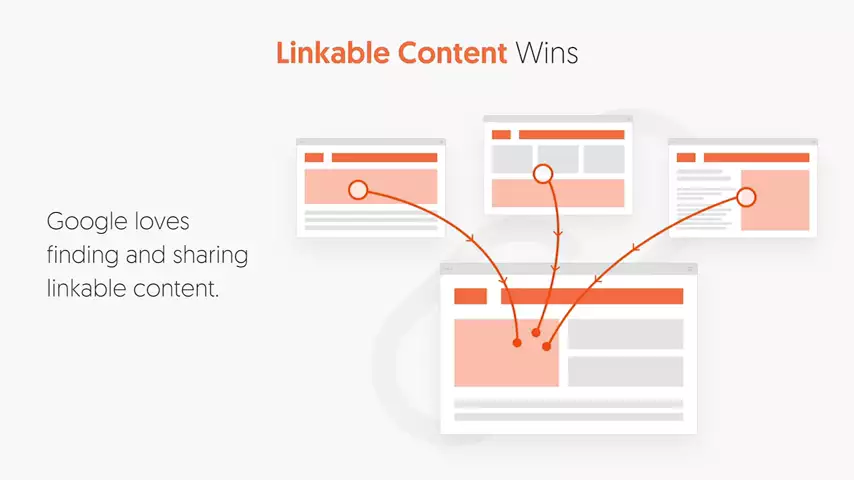 And there's many types of links that links other sites linking to you, as well as other pages within your site linking to other page within your site, as well.
And there's many types of links that links other sites linking to you, as well as other pages within your site linking to other page within your site, as well.
When you're going through your site and you're optimizing for Google, there's many factors that you need to look out for. But before I go into each of those factors, let me first show you how Google sees your website.Go to Browseo and put in your URL. This will show you how Google views your website. 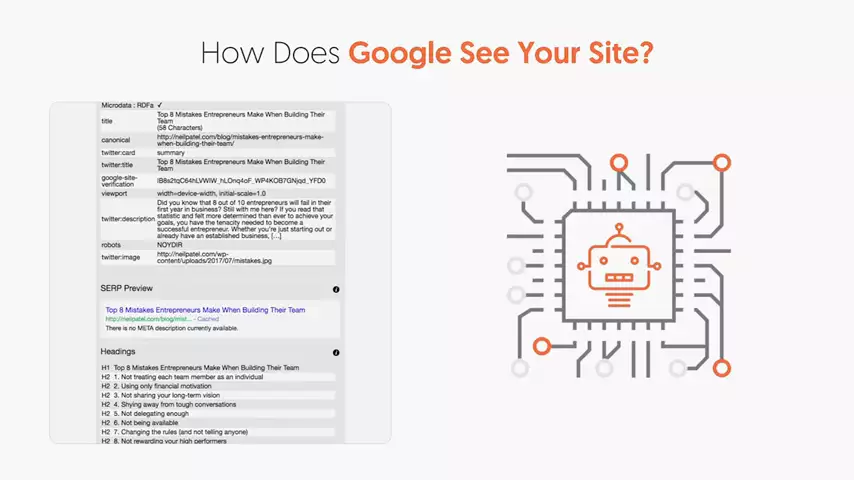
What you'll see is all this code and text. That's how Google looks at your website. They don't look at your website in a pretty user interface, or a pretty design. They don't see any of that. What you're seeing on the screen is roughly how they view your own website.
Now that you know how Google views your website, let's go into the 10 main elements when it comes to on-page SEO.
1. Titles
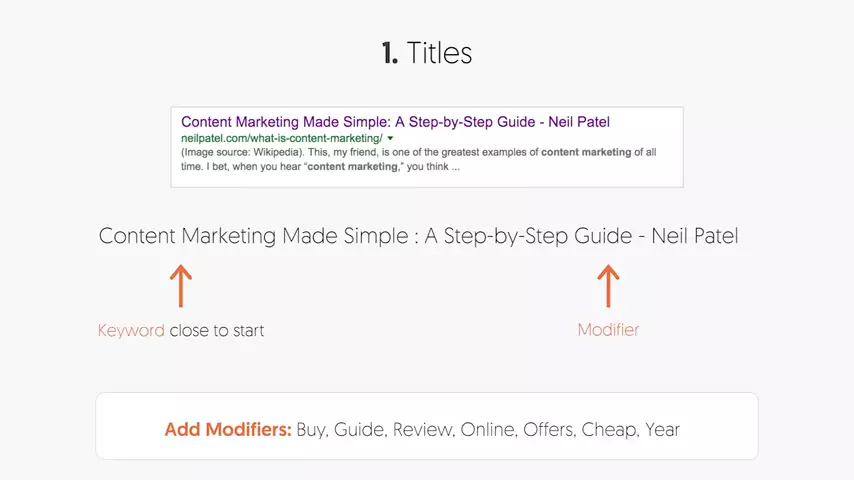 You know, whenever you do a Google search, you'll see this purple or bluish text at the top, then a green URL, and then, black text underneath. The text at the top is titles. That's your title tag. The middle one, the green, is your URL, of course, that's the URL of your website or your webpage. And below that is a description. That's called a meta-description. The title tags impacts clicks. If everyone does a search on Google and clicks on the second listing instead of the first listing, because the text and the title's more appealing, what do you think that tells Google. It tells Google, hey, everyone finds this second listing more relevant, so let's move it to number one, and let's move the original one that was ranking at the top back down to number two.
You know, whenever you do a Google search, you'll see this purple or bluish text at the top, then a green URL, and then, black text underneath. The text at the top is titles. That's your title tag. The middle one, the green, is your URL, of course, that's the URL of your website or your webpage. And below that is a description. That's called a meta-description. The title tags impacts clicks. If everyone does a search on Google and clicks on the second listing instead of the first listing, because the text and the title's more appealing, what do you think that tells Google. It tells Google, hey, everyone finds this second listing more relevant, so let's move it to number one, and let's move the original one that was ranking at the top back down to number two.
So you want to make your title's super-appealing, and the easy way to do this is, you put your keyword close to the front because someone's, typically, searching for a keyword when they're on Google, and then, you add a modifier towards the end. A modifier is words like buy, guide, review, online, offers, cheap. Sometimes, you can even include the year. Updated it in, and then, you would add the year. And we've found that, when you add the year, especially, for detailed guides, it drastically increases the click-through rate.
2. Headlines
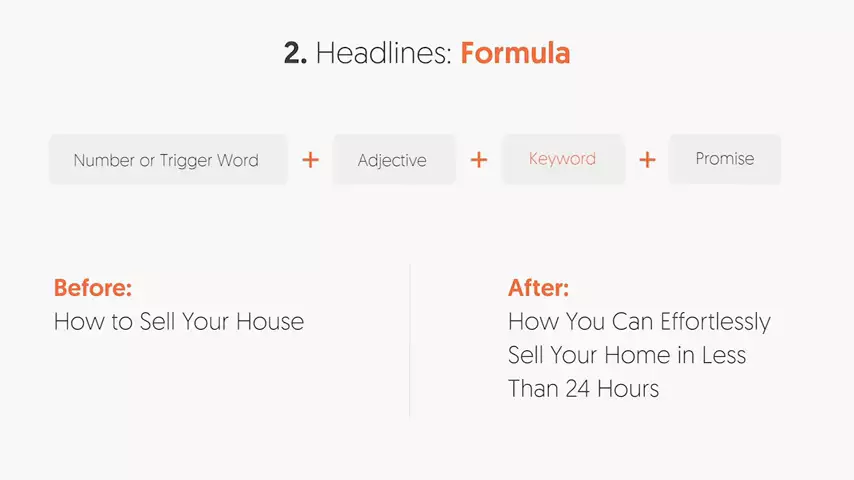 David Ogilvy always said that 80 cents of advertising campaign out of a dollar is spent in the headline. And it's true. Headlines are super-important. A quick stat for you: Eight of 10 people will read your headline, but only two out of 10 people will click through and read the rest of your copy. So if your headline's not good, you're going to lose them and you're going to miss the main opportunity to get people to your page and read the rest of your copy. With the headline, here's some formulas, right? Use a number or a trigger word at the beginning, then an adjective, then a keyword, and then, a promise. Remember, your headline is different than the title tag. This is, typically, the wording, or the phrase, or the sentence, title, whatever you want to end up calling it, that you use at the top of an article, or the top of a page. The title tag is what you show to someone who's searching Google, and that's what we discuss in the first point. But a headline is what's seen on your own website in the top of the page. People read it, they'll either bounce away or they'll scroll down and they'll read the rest of your copy.
David Ogilvy always said that 80 cents of advertising campaign out of a dollar is spent in the headline. And it's true. Headlines are super-important. A quick stat for you: Eight of 10 people will read your headline, but only two out of 10 people will click through and read the rest of your copy. So if your headline's not good, you're going to lose them and you're going to miss the main opportunity to get people to your page and read the rest of your copy. With the headline, here's some formulas, right? Use a number or a trigger word at the beginning, then an adjective, then a keyword, and then, a promise. Remember, your headline is different than the title tag. This is, typically, the wording, or the phrase, or the sentence, title, whatever you want to end up calling it, that you use at the top of an article, or the top of a page. The title tag is what you show to someone who's searching Google, and that's what we discuss in the first point. But a headline is what's seen on your own website in the top of the page. People read it, they'll either bounce away or they'll scroll down and they'll read the rest of your copy.
An example of someone not using my headline formula is, let's say, how to sell your house. Not that attractive, not that appealing. After using my formula, you can end up using things like, how you can effortlessly sell your home in less than 24 hours. People are like, oh, cool, that's great. I want to get rid of my home. I don't want to put in that much effort, and I want to get rid of it as quick as possible. You don't want to be deceptive with your headline. I'm giving you an extreme case here. Let's say, you're in the home-selling business and you know that you can't help people sell their home in 24 hours, don't put 24 hours in there. Maybe, you can do it within 30 days. That's still a good promise that'll cause a lot of people to click through.
Some quick tips.
- Short and sweet. Headlines at around six words tend to do better.
- Use numbers in there. People love numbers. Just imagine yourself going through the grocery store, in the checkout aisle, you see all these magazines. A lot of them have numbers there on the cover. It's because they know numbers work.
- Use interesting adjectives. Try negative words like, no, without, or stop.
- Also, make sure your headline matches the content. If it doesn't, you're going to lose trust with your readers or your website visitors.
When it comes to headlines, you also want to make sure that your getting a ton of shares on social sites like Facebook, or Twitter, or even LinkedIn, and here's some interesting stats for you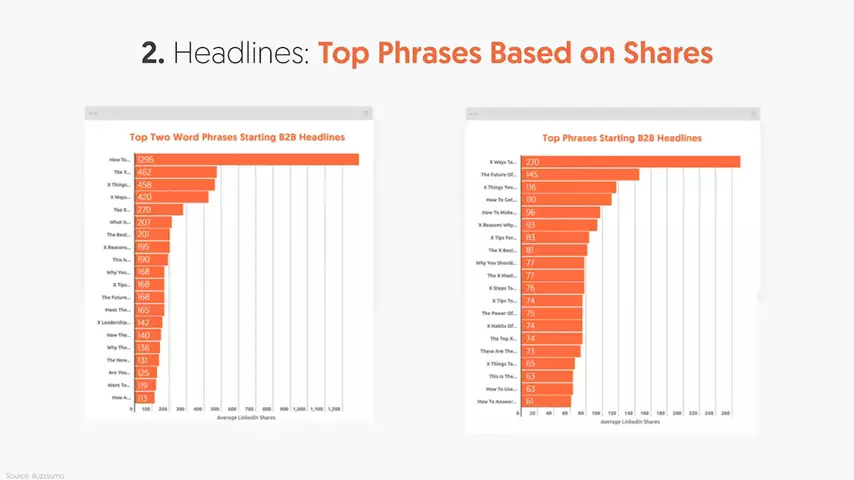 When you're looking at two-word phrases, the word, how to, generates more shares than any other two-word phrase that we're seeing, according to BuzzSumo. And when you're starting your headline, what I mean, start, the word at the very beginning of the headline, X Ways To tends to do the best. The number, or the word, X, or technically, the letter, X, would be replaced with a number such as five, 10, 15, 20. And when you're thinking, hey, what number should I put in there for X ways, well, first off, however many ways you have. That would be a way to start. And another things to look at is the total number of shares.
When you're looking at two-word phrases, the word, how to, generates more shares than any other two-word phrase that we're seeing, according to BuzzSumo. And when you're starting your headline, what I mean, start, the word at the very beginning of the headline, X Ways To tends to do the best. The number, or the word, X, or technically, the letter, X, would be replaced with a number such as five, 10, 15, 20. And when you're thinking, hey, what number should I put in there for X ways, well, first off, however many ways you have. That would be a way to start. And another things to look at is the total number of shares. 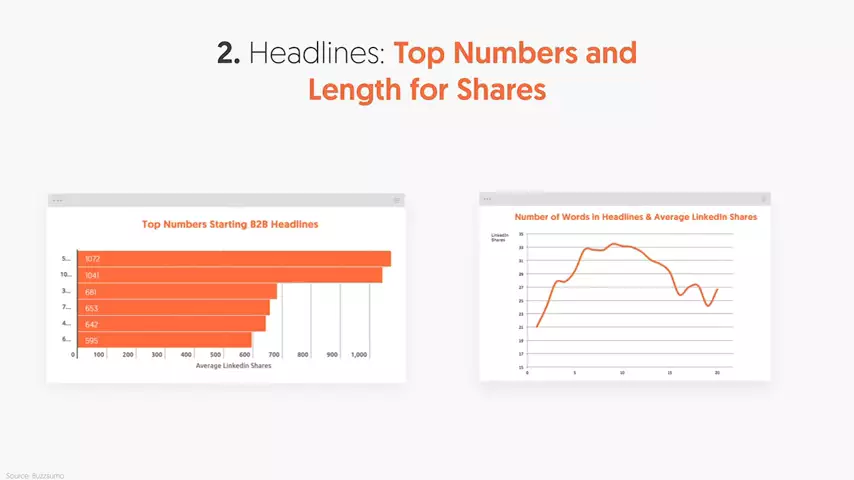 When it comes to numbers, the word, five, the number, 10, also do really well, and you can see that on the left graph when it comes to social sharing. And when it comes to the length of your headline, think about headlines that are roughly around six, seven, eight words, 10 words long. They do fine. If you go too long, you're going to get very little shares and, if you don't have enough words, you're not going to get that many shares, either.
When it comes to numbers, the word, five, the number, 10, also do really well, and you can see that on the left graph when it comes to social sharing. And when it comes to the length of your headline, think about headlines that are roughly around six, seven, eight words, 10 words long. They do fine. If you go too long, you're going to get very little shares and, if you don't have enough words, you're not going to get that many shares, either.
If you want to get the most amount of shares with your website and your blog posts or your resource pages, make sure you're using plugins like Social Pug, or Super Socializer. It's a great way to add the social-sharing icons to your site, and it does help generate a little bit more social shares. It doesn't give you a ton more, but every little bit adds up.
3. First hundred words on your webpage
Your first hundred words is what Google's crawling and they're like, hey, if these are your first words, typically, what you talk about in your first paragraph or two which is where your first hundred words usually are is going to be what the article is about. You would end up having your first two paragraphs have nothing to do what your webpage, your article, is about. That's why they're looking at your first hundred words really heavily. And you want to make sure you're dropping in your keywords within there. And you shouldn't have to manually force them in or stuff them. It should appear naturally. And, of course, you want to put ones that are more popular, the ones that are least popular, and you can use Ubersuggest. It'll show you what keywords are more popular than others.
4. Internal links
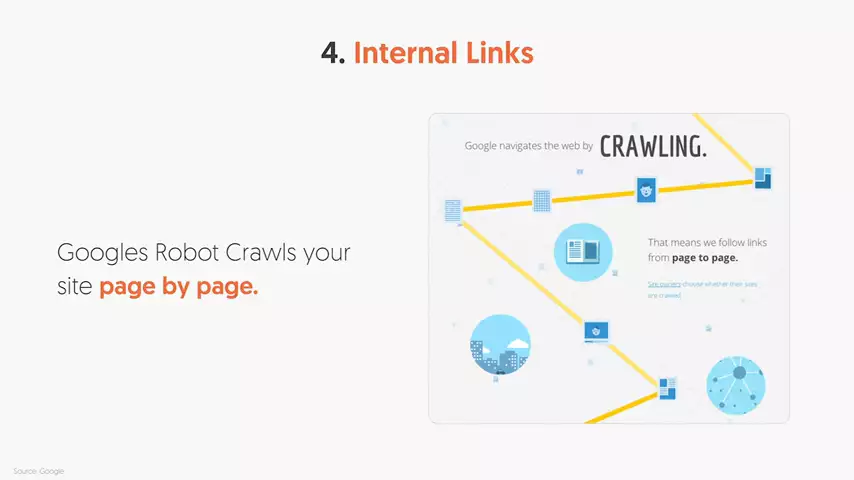 This is a cool graphic from Google, and they show you how they're crawling the web. When you're taking your pages and you're linking page to page, to page, it allows their crawler, their algorithm, to continually crawl your website and index every piece of content if they see fit. The reason I say, if they see fit, is, if they don't feel the page is that valuable, they may choose not to index it, or if the feel that the page is, doesn't have have unique content, they may choose not to index it. And we'll get into all those things later on, but I just wanted to give you a quick overview.
This is a cool graphic from Google, and they show you how they're crawling the web. When you're taking your pages and you're linking page to page, to page, it allows their crawler, their algorithm, to continually crawl your website and index every piece of content if they see fit. The reason I say, if they see fit, is, if they don't feel the page is that valuable, they may choose not to index it, or if the feel that the page is, doesn't have have unique content, they may choose not to index it. And we'll get into all those things later on, but I just wanted to give you a quick overview.
And internal linking is super-important. I rank very highly on Google for a lot of my head terms because I'm interlinking throughout my site. Another site that does this is Wikipedia. They rank for almost everything on Google because they're interlinking everywhere. And you can see it. 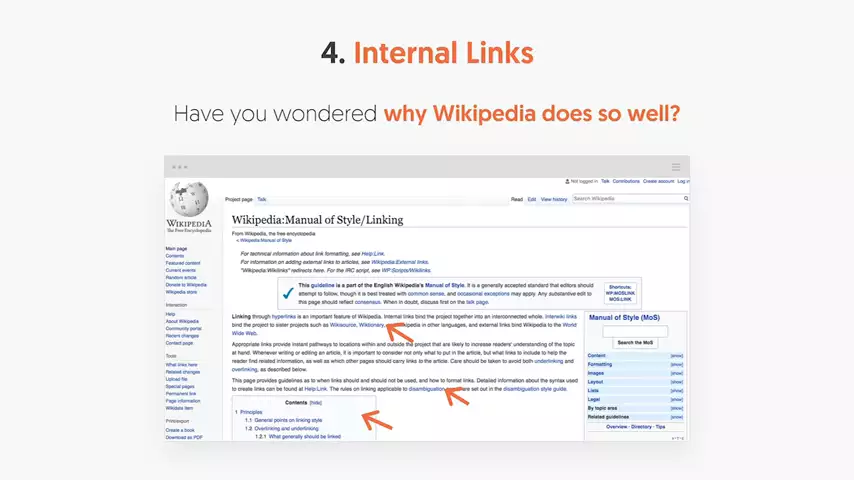 Whenever you read a piece of content, you'll see those blue links throughout their text, because that's the power of internal linking. It's what allows Wikipedia to continue to rank higher and higher.
Whenever you read a piece of content, you'll see those blue links throughout their text, because that's the power of internal linking. It's what allows Wikipedia to continue to rank higher and higher.
And here's a cool graphic from Brahma Media. 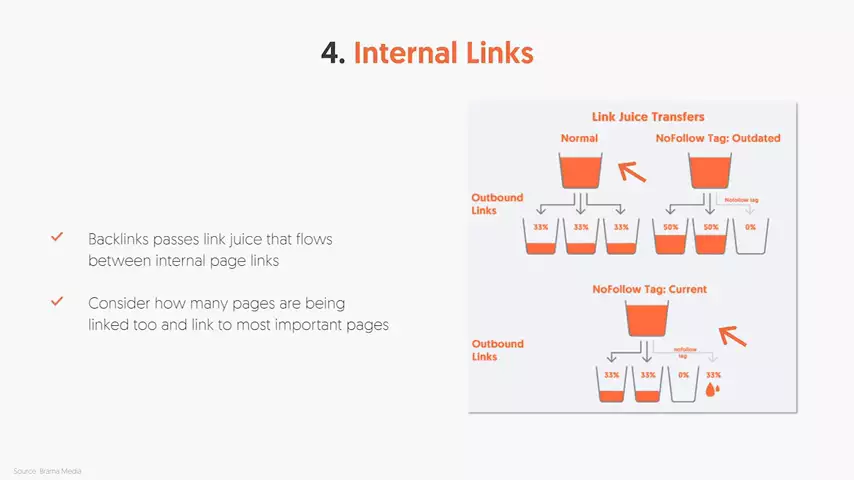 It shows you that, as you link from your homepage to other internal pages, you can have your links just flow throughout your site. Typically, not always, but typically, your homepage has the most authority, because a lot of people are linking to your homepage. And then, as you link to other pages on your site and you cross-link those other pages and those articles to other important pages, what you'll find is, it can bring up the rankings of your whole site overall.
It shows you that, as you link from your homepage to other internal pages, you can have your links just flow throughout your site. Typically, not always, but typically, your homepage has the most authority, because a lot of people are linking to your homepage. And then, as you link to other pages on your site and you cross-link those other pages and those articles to other important pages, what you'll find is, it can bring up the rankings of your whole site overall.
When you're doing your internal linking, make sure you put in keywords within the link. 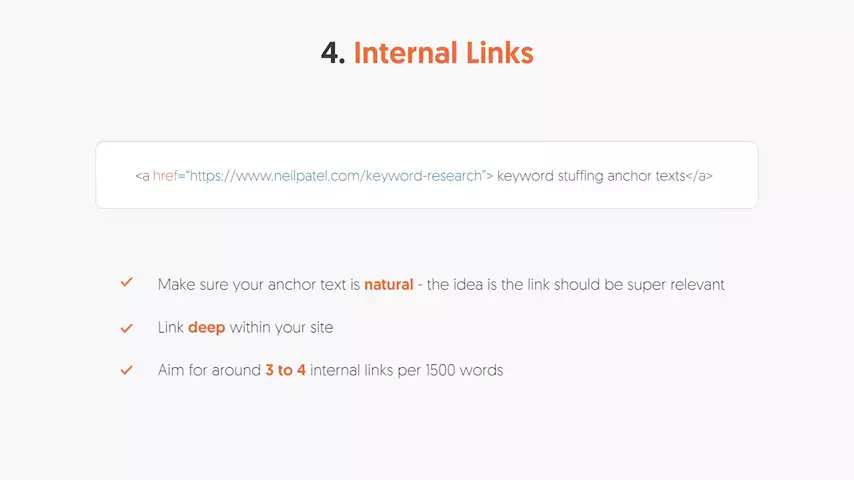 So, for example, here, you're seeing keyword-stuffing anchor text. That would be the text of the link. Here, I'm showing you the code. And the reason I'm showing you keyword-stuffing anchor text is because, although I want you to put keywords within the link, and that ends up helping you rank higher for that term, whatever it may be, like keyword-stuffing anchor text, it'll help you rank higher. But you need to be careful in not just stuffing keywords. Because if it's unnatural, it's not a good user experience. It's not just about adding in links and keywords. It's about doing what's also best for the user. You're not just optimizing for Google. You're also optimizing for users, as well.
So, for example, here, you're seeing keyword-stuffing anchor text. That would be the text of the link. Here, I'm showing you the code. And the reason I'm showing you keyword-stuffing anchor text is because, although I want you to put keywords within the link, and that ends up helping you rank higher for that term, whatever it may be, like keyword-stuffing anchor text, it'll help you rank higher. But you need to be careful in not just stuffing keywords. Because if it's unnatural, it's not a good user experience. It's not just about adding in links and keywords. It's about doing what's also best for the user. You're not just optimizing for Google. You're also optimizing for users, as well.
Typically, what I see is, if you have a 1,500-word article, you want to aim for at least three to four internal links. A lot of these links may be backing up your claims or linking to other relevant articles and, if you don't have three or four, that's fine. Don't just shove them for the sake of shoving them. Do what's natural and best for the user.
5. External links
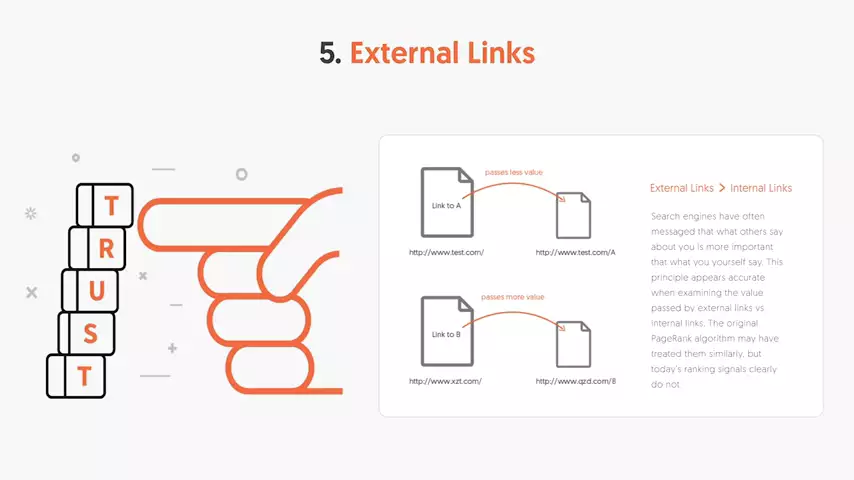 This is you linking to other websites, and also, other websites linking to you. A lot of times, you may be, "Hey, Neil, there's my competitor. "They have some great data. "But I don't want to link to my competitor." It's okay. There's nothing wrong with linking to your competitor. I don't it all the times because, if my competitor has some amazing stats and data, yes, I'm plugging them, but it provides credibility, as well, and it shows that I'm an authoritative figure because I'm not just making up stats and data or making up information. I'm telling you what to do backed by real data. So that's why external linking is real important. It also tells Google, hey, you are similar to these other websites. And, if some of them link back to you, or other websites in the same neighborhood link back to you, what I mean, neighborhood, I also have other marketing sites link back to me. It tells Google I'm a marketing site and I should be ranked for marketing-related keywords. If I had a pet website, and other dog sites link back to me, it would tell Google, hey, this site's related to pets, or dogs, and you should consider ranking them higher for dog or pet-related term.
This is you linking to other websites, and also, other websites linking to you. A lot of times, you may be, "Hey, Neil, there's my competitor. "They have some great data. "But I don't want to link to my competitor." It's okay. There's nothing wrong with linking to your competitor. I don't it all the times because, if my competitor has some amazing stats and data, yes, I'm plugging them, but it provides credibility, as well, and it shows that I'm an authoritative figure because I'm not just making up stats and data or making up information. I'm telling you what to do backed by real data. So that's why external linking is real important. It also tells Google, hey, you are similar to these other websites. And, if some of them link back to you, or other websites in the same neighborhood link back to you, what I mean, neighborhood, I also have other marketing sites link back to me. It tells Google I'm a marketing site and I should be ranked for marketing-related keywords. If I had a pet website, and other dog sites link back to me, it would tell Google, hey, this site's related to pets, or dogs, and you should consider ranking them higher for dog or pet-related term.
Make sure, when you link to the sites, you're linking to trustworthy sites that are reputable. Don't just link to Joe the Plumber because you like their design. Make sure their data, their facts, are relevant and accurate, because you don't want to deceive your own users because it'll reduce how much people believe in you and affect your trust.
6. URL Structure: Length
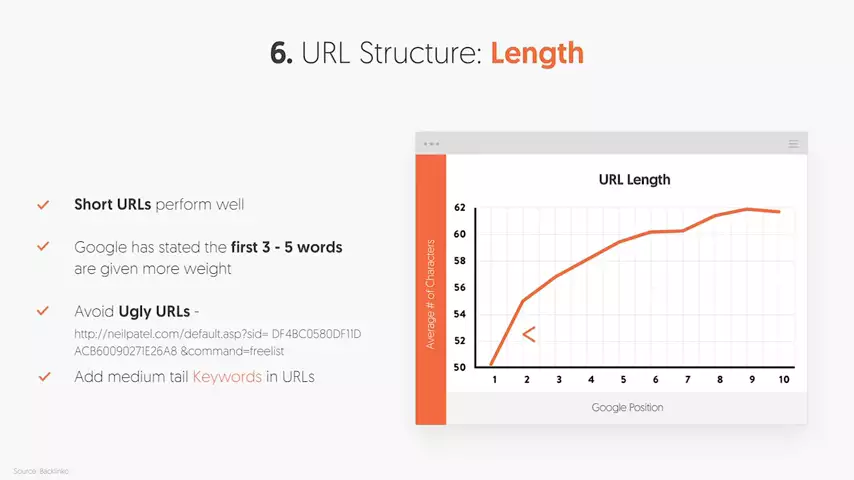 With your website, you also have a lot of pages. Your page all have unique URLs. URL links is really important. When your URL link is around 50 characters, you'll tend to rank better than if it is 60 characters, or 70, or 80. So try to keep your URL short and to the point. Keep them clean. You don't want all these crazy words or characters in there, like question marks and equal signs. You want to keep it clean, to the point. Use letters, use numbers. This is really important in URLs because, the more messy it is, what you'll find is, the lower you'll rank. And a lot of people are like, no, I want my URL to be really long so I can put in all my keywords.
With your website, you also have a lot of pages. Your page all have unique URLs. URL links is really important. When your URL link is around 50 characters, you'll tend to rank better than if it is 60 characters, or 70, or 80. So try to keep your URL short and to the point. Keep them clean. You don't want all these crazy words or characters in there, like question marks and equal signs. You want to keep it clean, to the point. Use letters, use numbers. This is really important in URLs because, the more messy it is, what you'll find is, the lower you'll rank. And a lot of people are like, no, I want my URL to be really long so I can put in all my keywords.
Well, Google will think that your URL is only related to somebody who searches for all those keywords, plus you'll rank for the long-tail phrases, as well. Long-tail phrase, just as a quick recap if you're not familiar with that, is when people are doing a Google search for three, four, five-word phrases on Google.
With your URL structure, make sure you don't include dates.I removed dates from my URL structure on neilpatel.com. By doing this, I've boosted my SEO traffic by 50% in roughly 30 days. I kid you not. And here's an example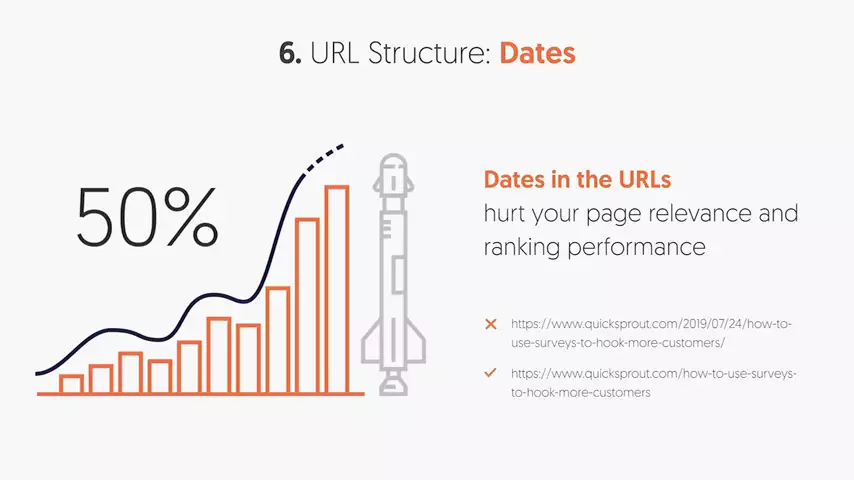
Quicksprout.com/2019/07/24, and then, the title of the article. By removing the date, Google will be like, oh, cool, this article is still relevant. Because 2019 happened a long time ago, right? We're way past 2019. But the article on how surveys can hook more customers, that's still relevant in future years. But when you have a date in your article, Google will be like, it's not 2019 anymore, so we shouldn't rank this article as highly. But when you remove the date, it tells Google, wait, this isn't a news-related article. It's not relevant to a specific time period. It's still relevant in the future. So make sure you don't have date in your URL. And if you have dates in your URL, you can't just remove them. You've got to remove them and 301 redirect your old URLs, the ones with the dates, to the new ones.
You'll also want to make sure that you're using a SSL certificate. Most of the webpages that rank on Google use that SSL certificate. 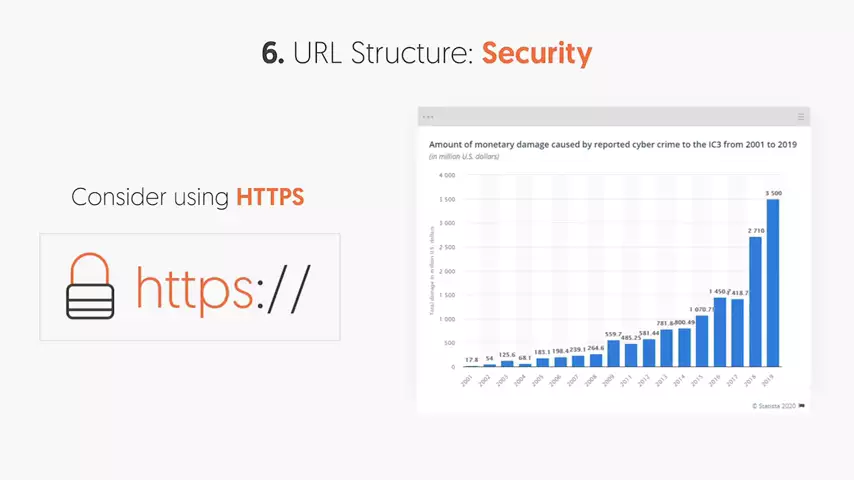 This makes your URL, instead of HTTP, it adds that S at the end. So then, you'll be HTTPS. You know, when you go to a website and it says Not Secure? Usually, it's because they're not using an SSL certificate. So you want to make sure that you're using an SSL certificate, not only because it helps with rankings, but it also helps with conversions.
This makes your URL, instead of HTTP, it adds that S at the end. So then, you'll be HTTPS. You know, when you go to a website and it says Not Secure? Usually, it's because they're not using an SSL certificate. So you want to make sure that you're using an SSL certificate, not only because it helps with rankings, but it also helps with conversions.
Some general URL tips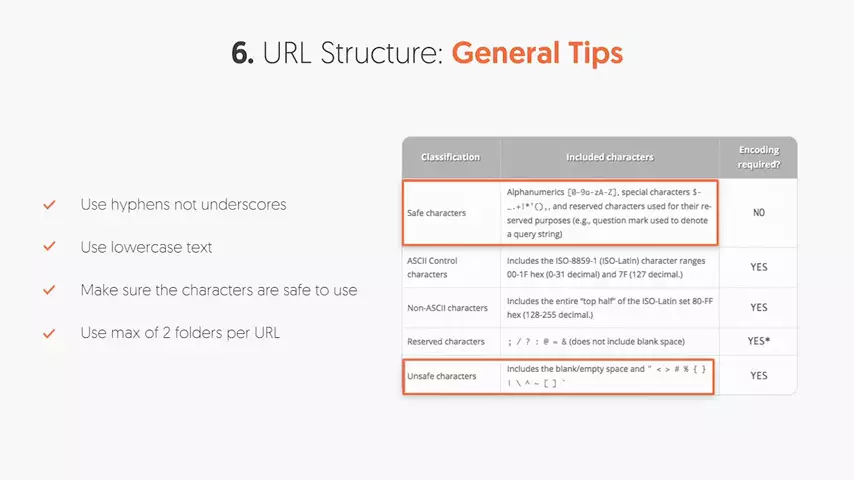
Use hyphens, not underscores. Use lowercase text. Use characters that are safe. So no And signs, no Pound signs, no squiggly marks or anything that isn't letters, numbers, or dashes, to keep things simple. And try to keep you URLs at a max of two folders. Because whenever someone does a search, it may be your domain.com/aword/, and then, another word or two words. The slashes are folders. So you don't want, ideally, more than two slashes. Sometimes, you have more but try to keep in in that realm.
7. Readability
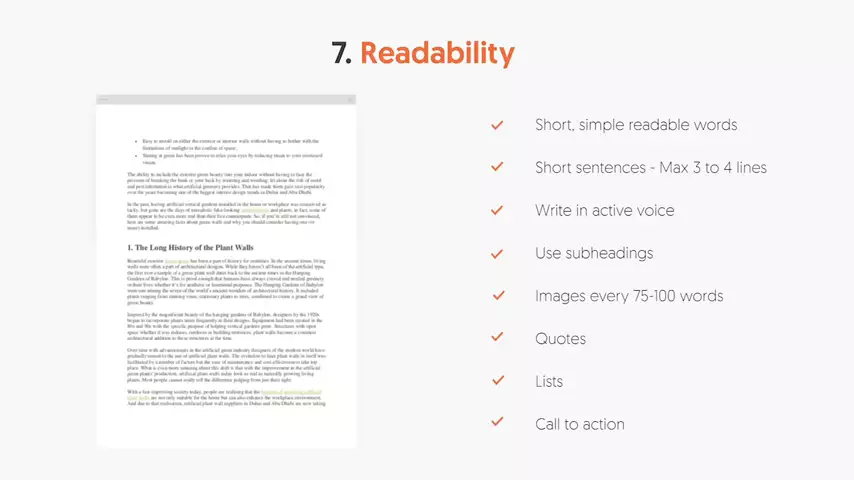 If people are on your site, they're there to read, and then, figure out if they want to buy, or consume information. But if you're text isn't readable, people aren't going to stick around. I like doing things like keeping my words on my page really simple and easy to understand. I'm not trying to impress someone who went to Harvard. I don't have amazing grammar or spelling skills. Keep it simple. Don't talk above people's heads. Use short sentences, that way, it's easier to skim. I try to keep my sentences and paragraphs at a max of three to four lines. Sometimes, if I have more desktop readers, you can do five to six. But a lot of people are on mobile devices these days, you also want to use subheadings, you want to use images, quotes, lists, and call to actions. And now, I'm going to dive into each of them a little bit more.
If people are on your site, they're there to read, and then, figure out if they want to buy, or consume information. But if you're text isn't readable, people aren't going to stick around. I like doing things like keeping my words on my page really simple and easy to understand. I'm not trying to impress someone who went to Harvard. I don't have amazing grammar or spelling skills. Keep it simple. Don't talk above people's heads. Use short sentences, that way, it's easier to skim. I try to keep my sentences and paragraphs at a max of three to four lines. Sometimes, if I have more desktop readers, you can do five to six. But a lot of people are on mobile devices these days, you also want to use subheadings, you want to use images, quotes, lists, and call to actions. And now, I'm going to dive into each of them a little bit more.
So when it comes to images, you want to create images or use images sites where you can get images like pexels.com, for free. 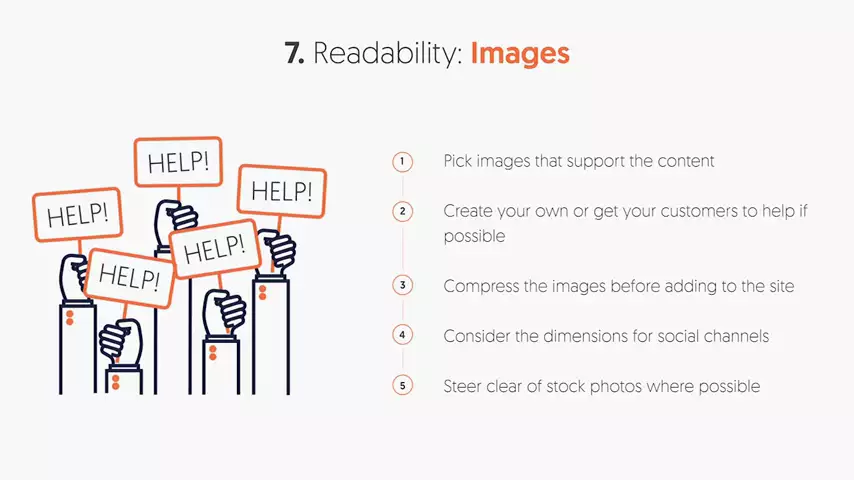 You want to try to create your own images when possible. People like custom-made images. Make sure that they're compressed in size, they're small. You don't want them blurry. But there's a lot of tools out there. If you just Google, compress your image, they'll compress them and keep the quality similar. So that way, they load faster for people. And you also want to consider the dimensions for social channels, as well. If you don't consider the dimensions, then what'll happen is people won't be able to easily share them on Facebook or LinkedIn. And you want to avoid stock photography when possible. Yes, there are sits like Pexels for free that you can use as a last resort, but they tend not to do as well as custom images.
You want to try to create your own images when possible. People like custom-made images. Make sure that they're compressed in size, they're small. You don't want them blurry. But there's a lot of tools out there. If you just Google, compress your image, they'll compress them and keep the quality similar. So that way, they load faster for people. And you also want to consider the dimensions for social channels, as well. If you don't consider the dimensions, then what'll happen is people won't be able to easily share them on Facebook or LinkedIn. And you want to avoid stock photography when possible. Yes, there are sits like Pexels for free that you can use as a last resort, but they tend not to do as well as custom images.
With your images, you also have to keep in mind that Google can't see them, right? Remember how I showed you how Google looks at a page when you go to Browseo? So you want to use an Alt Tag to describe what your image is.
<img src="/image.webp" alt="Keyword description" title="Keyword tooltip" />
And you can see here, that little code snippet. And my title, a tooltip when someone hovers over the image, I would also use the same, typically, as my Alt Tag. And you're probably wondering, why do I need to do all of this? Well, one, it helps Google. On top of that, it helps people with disabilities. Because they use programs that help them describe a website. And, of course, if Google's going to rank a website, why not rank a website that's great for all people, even ones who are disabled because there's so many people out there who have disabilities. So please, do thank you to make your website compatible for them as well.
When you're looking at image sourcing, some sites to also check out is Envato or Graphic River. Those are two awesome sites, as well.
Subheadings
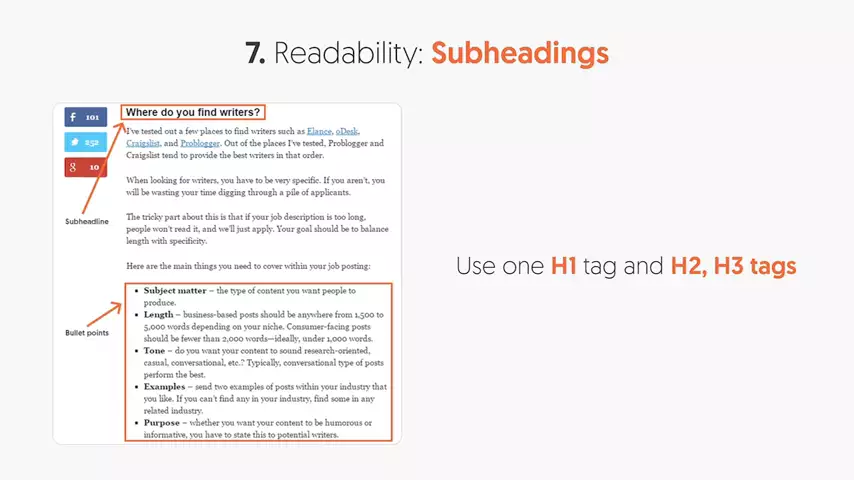 Think of your title, your heading on a page, as an H1, but then, you have subheadings, right? You have the title of your book. That's like the title of your article. But then, there's also chapters in a book. Chapter One, Chapter Two, Chapter Three. Those are what is considered subheadings. And, typically, your subheadings are using H2 heading tags, or H3 heading tags. And, if you're not sure if you're using them right, you can go to Ubersuggest, type in your URL, and then, on the left navigation, click on Site Audit, and it'll analyze your headings and all your code for you and tell you what's wrong there, as well.
Think of your title, your heading on a page, as an H1, but then, you have subheadings, right? You have the title of your book. That's like the title of your article. But then, there's also chapters in a book. Chapter One, Chapter Two, Chapter Three. Those are what is considered subheadings. And, typically, your subheadings are using H2 heading tags, or H3 heading tags. And, if you're not sure if you're using them right, you can go to Ubersuggest, type in your URL, and then, on the left navigation, click on Site Audit, and it'll analyze your headings and all your code for you and tell you what's wrong there, as well.
With your webpages, call to actions ar really important when it comes to readability. If your calls to actions don't stand out in color and they're not clear, you won't do well. Make sure, when you're picking the color, do not use red. Red is typically a color for Stop, like a stop sign, or a stoplight. So you want to avoid red, but you can use any other color. Just make sure it stands out and there's a good difference between the color on your page. So, for example, if my page has a ton of blue, I may use green instead, or I may use orange, or I may use, I don't know, purple, or pink, you know, pick any, or yellow. I don't know what goes with blue, but you get the point I'm trying to make. You wouldn't want to use the exact same color.
Also, another thing I do throughout my blog posts is, I use a lot of quotes and bullet points. It makes things so much easier to read and skim. Keep in mind, not everyone's going to read your content. A lot of people are skimming it. So using quotes and using bullet points makes things so much easier to skim. That's also why I love creating infographics. They're like a visual piece of content that shows people information and images and it makes it easier to understand and skim.
8. Video
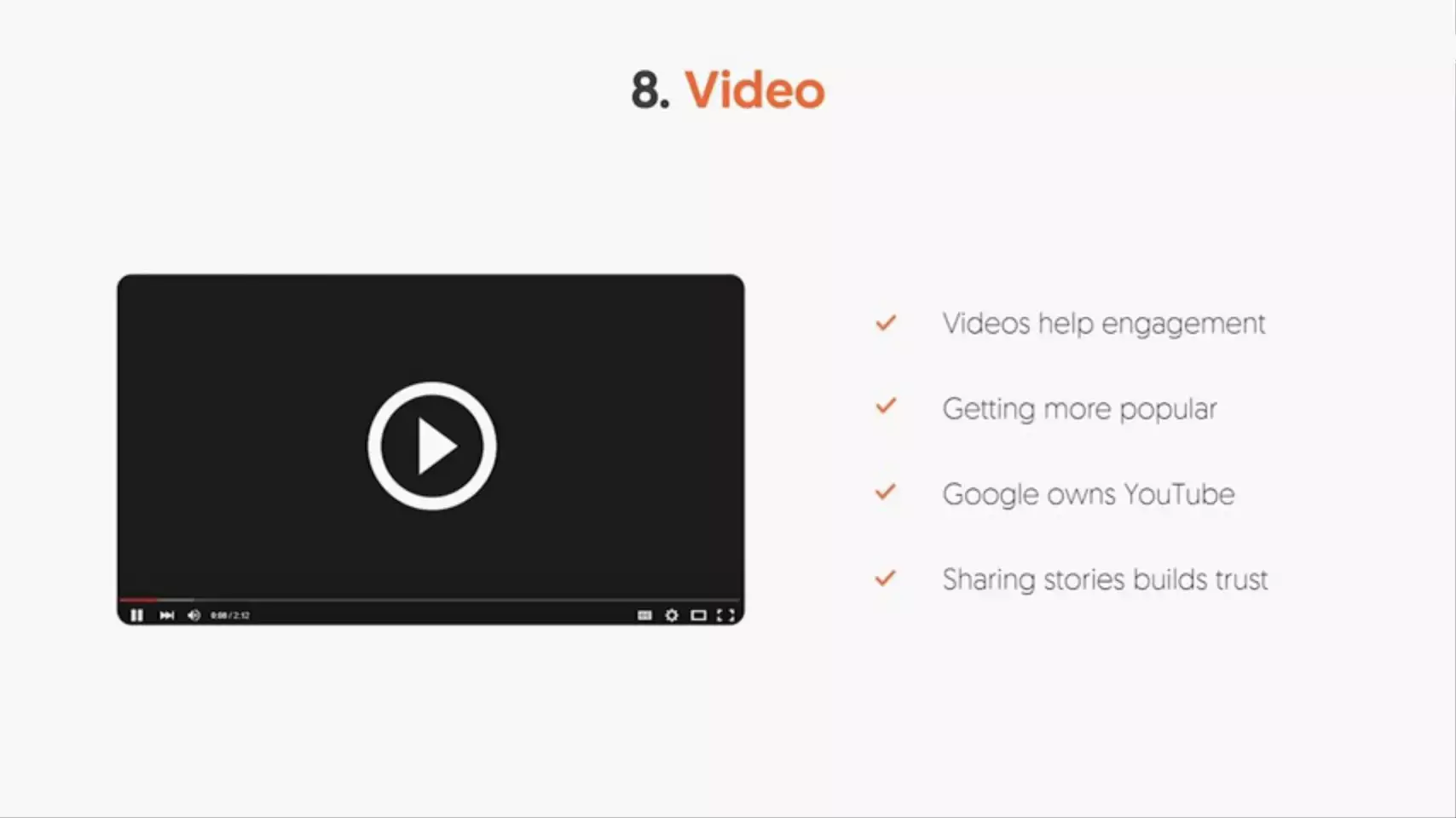 And these days, everyone is watching videos. YouTube is one of the most popular websites. It makes up a decent chunk of Google's market cap. So make sure you're including videos when it's relevant. And videos are also a great thing for your leverage. You can get a ton of traffic from videos, as well, because YouTube is the second-most popular search engine.
And these days, everyone is watching videos. YouTube is one of the most popular websites. It makes up a decent chunk of Google's market cap. So make sure you're including videos when it's relevant. And videos are also a great thing for your leverage. You can get a ton of traffic from videos, as well, because YouTube is the second-most popular search engine.
9. LSI: Latent Semantic Indexing
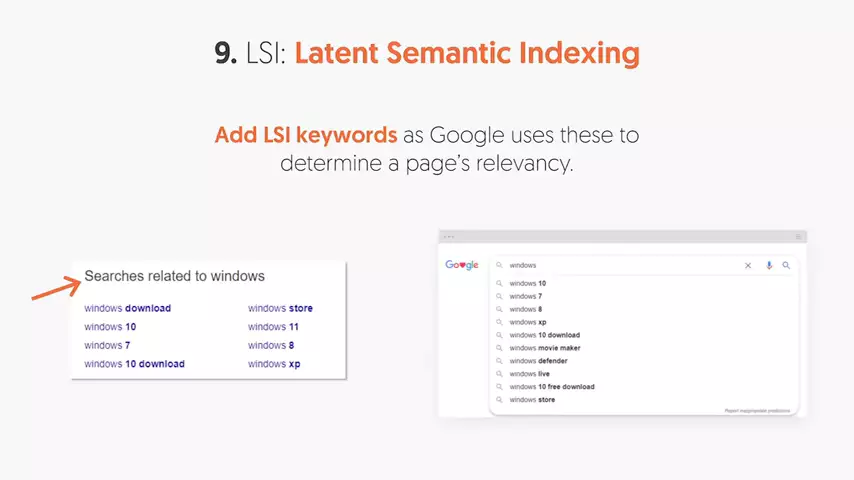 Another factor to look at is related keywords. Google knows that, when you do a search for Windows, you're not just looking at Windows operating systems, like Windows 10. You may be looking at older versions like XP, or 8 or or 7. And you can see at the bottom of Google, whenever you do a search, it'll show you other related searches.
Another factor to look at is related keywords. Google knows that, when you do a search for Windows, you're not just looking at Windows operating systems, like Windows 10. You may be looking at older versions like XP, or 8 or or 7. And you can see at the bottom of Google, whenever you do a search, it'll show you other related searches.
This is their own latent semantic indexing, and you can also use Ubersuggest, when you go to the keyword ideas report on the left side. When you put in any keyword that you're trying to rank for, it'll show you all the other related keywords that Google looks at, and you want to try to integrate some of these keywords within your page, as well. Because if you want to rank for the main keyword, might as well rank for all the relevant, related keywords, as well. It's an easy way to get more traffic.
The interesting thing is, whenever you do a Google search and you type in a keyword, you'll notice that it bolds the keywords that you typed in when they're there on the page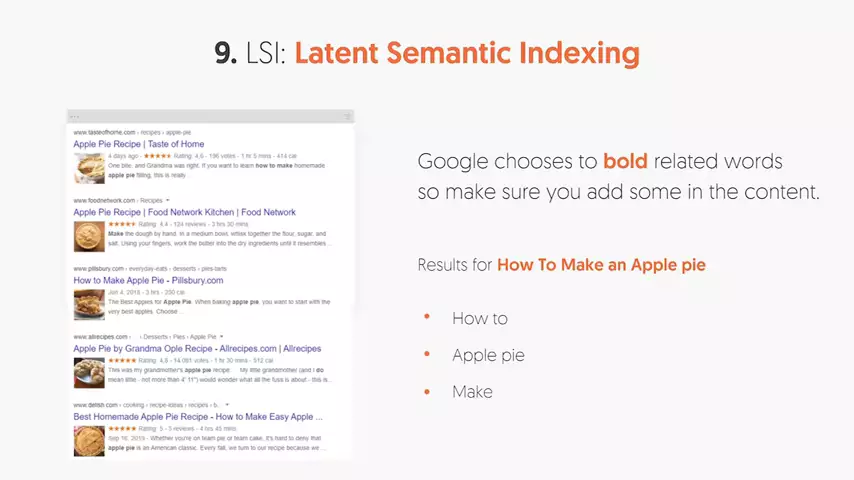 such as How To, or Apple Pie, or Make, and this allows you, as a user, to clearly see, hey, these pages have what you're discussing. That's the importance of keywords, so make sure that you're including the right keywords within your page, in your title, in your headings, if you want to rank. If you don't, you won't do well.
such as How To, or Apple Pie, or Make, and this allows you, as a user, to clearly see, hey, these pages have what you're discussing. That's the importance of keywords, so make sure that you're including the right keywords within your page, in your title, in your headings, if you want to rank. If you don't, you won't do well.
10. Social Sharing
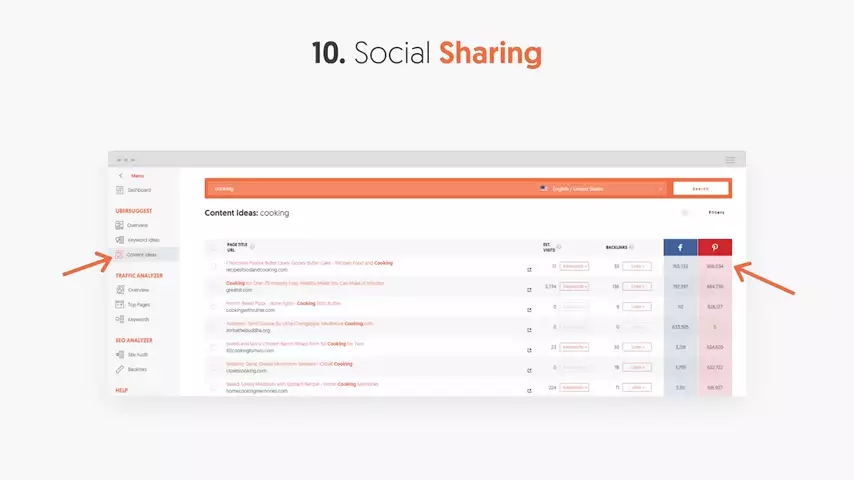 On Ubersuggest, whenever you type in a keyword, and then, you go into the content ideas report on the left side, it'll show you all the popular blogs around the web that have a ton of social shares. You want to created content around things that are going to be popular. And what's cool about this report is it shows you what's already done well. Because, if something has done well, the chances are, it'll continually do well in the future.
On Ubersuggest, whenever you type in a keyword, and then, you go into the content ideas report on the left side, it'll show you all the popular blogs around the web that have a ton of social shares. You want to created content around things that are going to be popular. And what's cool about this report is it shows you what's already done well. Because, if something has done well, the chances are, it'll continually do well in the future.
If a lot of topics don't get a lot of social shares, because you can keep going to the next page, and the next page, and the next page, on the content ideas report within Ubersuggest, and I recommend that, you'll start seeing what's less popular. You'll want to avoid writing stuff that not that popular, and you'll want to write on more of the stuff that is really popular.
What's also cool about this report, too, is it breaks down the estimated visits and backlinks. The holy grail is writing stuff that gets a ton of estimated visits, a lot of backlinks, and a lot of social shares. If you do that, you can do extremely well.
That's it for this lesson.
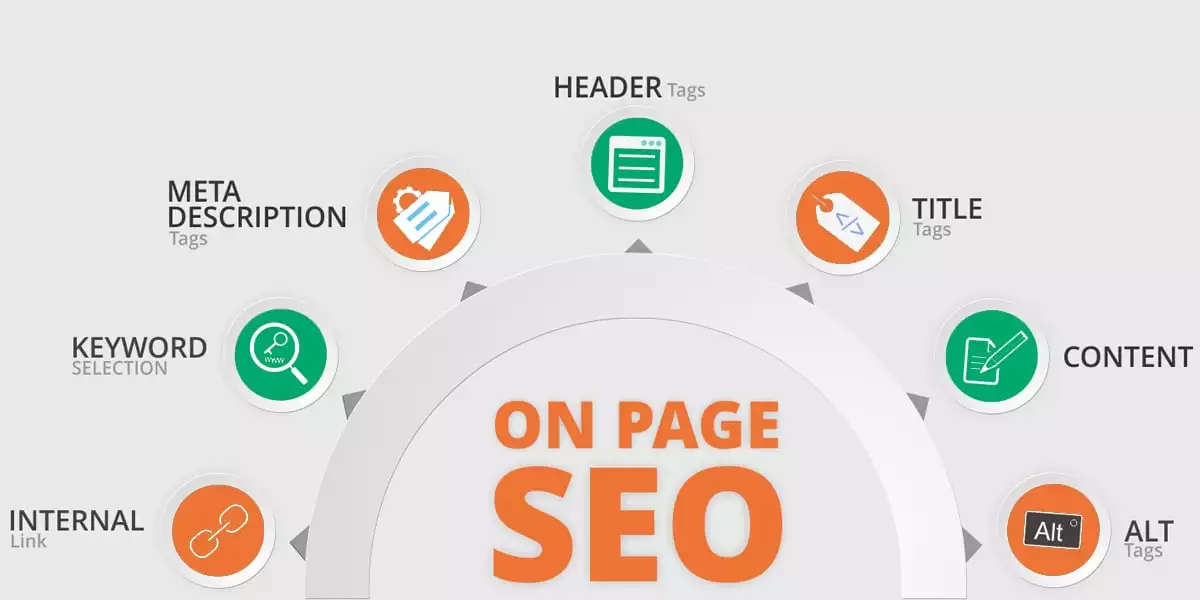

No comments yet